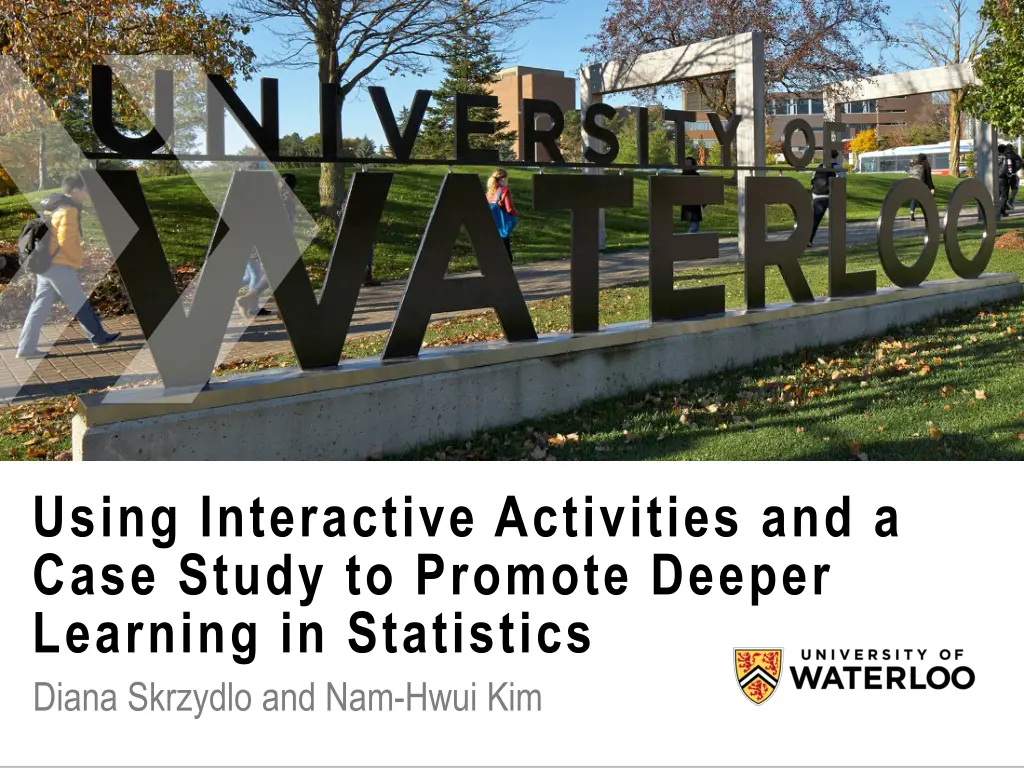
Promoting Deeper Learning in Statistics Through Interactive Activities and Case Study
Explore how to enhance statistical education by engaging students through interactive tutorial activities, case study competitions, and oral final exams. Discover the motivation behind this approach, the activities implemented, outcomes measured, and insights gained for future teaching strategies.
Download Presentation

Please find below an Image/Link to download the presentation.
The content on the website is provided AS IS for your information and personal use only. It may not be sold, licensed, or shared on other websites without obtaining consent from the author. If you encounter any issues during the download, it is possible that the publisher has removed the file from their server.
You are allowed to download the files provided on this website for personal or commercial use, subject to the condition that they are used lawfully. All files are the property of their respective owners.
The content on the website is provided AS IS for your information and personal use only. It may not be sold, licensed, or shared on other websites without obtaining consent from the author.
E N D
Presentation Transcript
Using Interactive Activities and a Case Study to Promote Deeper Learning in Statistics Diana Skrzydlo and Nam-Hwui Kim
Outline Motivation Activities Used Measuring Outcomes Analysis What We Learned Going Forward
Motivation STAT 334 has historically been taught as most statistics courses are Lectures, midterms, assignments, final exam But students are not Statistics majors Don t want to be there Unclear understanding of theoretical models Don t see relevance to real world Goal: Try to engage students and provide deeper learning
Activities Used Interactive Tutorial Activities Case Study Competition Oral Final Exam
Interactive Tutorial Activities 3 questions focusing on topics from class Rotating groups each week Particular focus on confusing concepts Instructor and TAs actively assisting Graded (mostly for effort) and returned Solutions posted promptly Special topics: pre- and post-course questionnaire, midterm review, midterm take-up, Markov Chain exploration
Case Study Competition Groups of 3 students Had to choose a topic and model it with a Markov Chain Presentations in class Cash prizes for winners chosen by panel of judges Reports due afterwards to incorporate feedback from presentations Personal reflection paper on learning from own and others presentations
Oral Final Exam Before the written Final Exam Conversation style 5 Questions randomly selected from a bank: Define Advantages & Disadvantages Compare & Contrast Describe a Process Impact of a Change 15 minutes per student Open book
Measuring Outcomes Beforehand, we identified tools to measure outcomes: Pre- and Post-course questionnaire Case Study reflection Post-course survey Grades in the course Grades in the follow-up course Student course evaluations
Pre- and Post-Course Questionnaire Results Average accuracy improved 2.45 pts out of 8 (31%) Each point gained 1.5% higher final grade (significance level p=0.03) Average 51% of possible improvement Each 10% improvement 1.2% higher final grade (significance level p=0.007)
Case Study Reflections Having taken many courses so far in my academic career, this case study was completely different from any other assignment I have done. It gave me a more hands-on and in-depth approach to learn the material. I found it very interesting to learn the real-life applications of Markov Chains, and not just the theory behind the concept. As well, researching a topic to choose helped me to see the array of applications of Markov Chains.
Case Study Reflections I was unwittingly understanding and applying Markov Chains while I was working on the case study competition. It was a satisfying experience and a great alternative way to learn course material.
Case Study Reflections The application of Markov Chains in our real life problems allowed us, as a class, to see the very appropriate application of one simple statistical concept in a kaleidoscope of areas in the world we live in today. The experience to me was one of the first, which I felt strengthened my conviction on the application of Math in everyday life.
Most positive survey results 98% tutorials enriched learning experience 89% case study enriched experience 86% case study helped learn course concepts 76% the freedom to choose their topic improved their motivation 93% found the course beneficial and meaningful
Learning from Failure: least positive survey results 62% enough time was given for the case study 65% the case study reflection helped evaluate their learning Many students mentioned the tutorial questions were too long when asked what to improve
Grades Grades in STAT 334 were about 1% higher than in previous terms but that could also be attributed to a different instructor, grading, or cohort of students Unfortunately, no statistically significant difference was found in the grades in the follow-up course, based on the STAT 334 teaching method.
Student Course Evaluations Again we have some confounding with instructor/cohort, but a higher percentage than the previous 2 years rated the course as very interesting (42% vs 29%)
What We Learned The First Time Tutorial Activities Give shorter tutorial activities Give clearer instructions Case Study Competition Give more time to form groups, choose topics Give clearer expectations and content suggestions for presentation and report Oral Exams Give opportunity to practice Explain purpose and motivation
Going Forward Is it sustainable? Tutorial Activities Yes, easily. Already passed on materials to next instructor Case Study Competition Could just be done as a regular project No need for panel and cash prizes Oral Exams Only if class size permits

